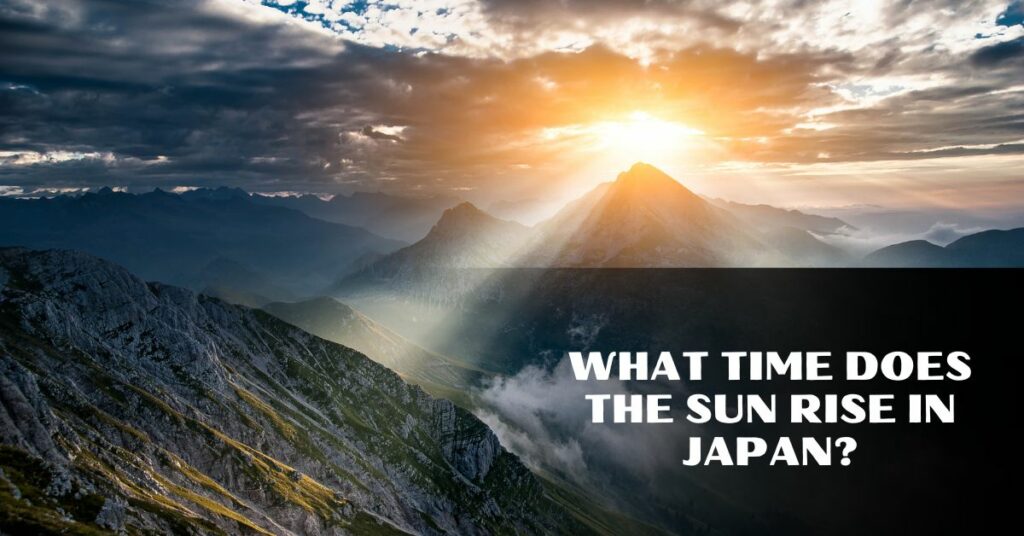The rising of the sun is a daily event that occurs all around the world. In Japan, the time at which the sun rises can vary depending on the season and location. In this article, we will explore the average sunrise times in Japan by season, as well as how to find out the exact sunrise time for a specific location in the country. We will also discuss the various factors that can affect the sunrise time in Japan, such as latitude, altitude, and atmospheric conditions. Additionally, we will touch upon the cultural and historical significance of the sunrise in Japan, as well as the different ways in which it is celebrated or observed. Finally, we will provide some tips for capturing beautiful photographs of the sunrise in Japan, including popular locations and camera settings.
The average sunrise times in Japan by season.
One of the key factors that determines the time at which the sun rises in Japan is the season. In general, the sun rises earlier in the summer months and later in the winter months, due to the country’s location in the northern hemisphere.
During the summer months of June, July, and August, the sun typically rises between 4:30 and 5:30 AM in most parts of Japan. This is due to the longer days and shorter nights that occur during the summer season. In the winter months of December, January, and February, the sun rises closer to 7:00 AM in most parts of the country. This is due to the shorter days and longer nights that occur during the winter season.
It is worth noting that the exact sunrise times can vary somewhat depending on the specific location in Japan. For example, the sun may rise slightly later in the northern regions of the country due to their higher latitudes, and it may rise slightly earlier in the southern regions due to their lower latitudes. The altitude of a location can also affect the sunrise time, with the sun rising earlier at higher altitudes due to the lack of obstructions on the horizon.
Overall, the average sunrise times in Japan by season are as follows:
- Summer (June, July, August): 4:30-5:30 AM
- Fall (September, October, November): 5:30-6:30 AM
- Winter (December, January, February): 7:00-8:00 AM
- Spring (March, April, May): 6:00-7:00 AM
It is important to note that these are just rough estimates, and the actual sunrise times can vary somewhat depending on the specific location and atmospheric conditions. To find out the exact sunrise time for a specific location in Japan, it is best to use a sunrise calculator or refer to a local weather forecast.
How to find out the exact sunrise time for a specific location in Japan.
If you are planning a trip to Japan and want to know the exact sunrise time for your location, there are a few different resources that you can use. One of the most accurate and convenient options is to use a sunrise calculator. These online tools allow you to enter your location and the specific date that you are interested in, and they will provide the exact time at which the sun will rise on that day.
To use a sunrise calculator, simply follow these steps:
- Search for a sunrise calculator online and select a reputable site.
- Enter your location into the calculator by typing in the name of the city or town, or by entering the latitude and longitude coordinates.
- Select the date that you are interested in.
- Click the “Calculate” button to get the exact sunrise time for your location on that date.
It is worth noting that the accuracy of sunrise calculators can vary somewhat, as they rely on data from various sources such as weather forecasts and astronomical calculations. However, they are generally very accurate and can provide a good estimate of the sunrise time for your location.
In addition to using a sunrise calculator, you can also check the local weather forecast for the sunrise time. Most weather forecasts provide the sunrise and sunset times for the day, and you can use this information to plan your activities accordingly. Finally, you can also ask locals or hotel staff for the sunrise time in the area, as they may have a good understanding of the daily patterns in their region.
Factors that can affect the sunrise time in Japan, such as latitude, altitude, and atmospheric conditions.
There are several factors that can affect the sunrise time in Japan, which can cause the actual time at which the sun rises to vary somewhat from the average times listed above. Some of the main factors that can affect the sunrise time in Japan include:
- Latitude: The latitude of a location determines its distance from the equator, and this can affect the sunrise time. In general, the sun rises earlier at lower latitudes and later at higher latitudes. This is because the sun’s rays hit the Earth at a more perpendicular angle at the equator, whereas they hit the Earth at a more oblique angle at higher latitudes. As a result, the sun appears to rise and set more slowly at higher latitudes, leading to longer days and shorter nights.
- Altitude: The altitude of a location can also affect the sunrise time. At higher altitudes, the sun appears to rise and set more quickly due to the lack of obstructions on the horizon. As a result, the sun may rise slightly earlier at higher altitudes and set slightly later.
- Atmospheric conditions: The atmospheric conditions can also affect the sunrise time, as clouds, haze, and other atmospheric phenomena can obscure the sun’s rays and make it appear to rise or set later than it actually does. For example, if there is a thick layer of clouds on the horizon, the sun may appear to rise later than it normally would.
Overall, it is important to keep these factors in mind when trying to determine the sunrise time in Japan. While the average sunrise times listed above can provide a good estimate, the actual time at which the sun rises can vary somewhat depending on the specific location and atmospheric conditions.
The cultural and historical significance of the sunrise in Japan.
The sunrise has long been an important aspect of Japanese culture and has played a significant role in the country’s history, religion, and daily life. In Japan, the sunrise has traditionally been seen as a symbol of renewal and a time of hope, and it has been celebrated and observed in a number of different ways throughout the country’s history.
One of the most well-known celebrations of the sunrise in Japan is the annual New Year’s Day sunrise viewing ceremony, known as “Hatsuhinode.” This ceremony involves people gathering at sunrise on the first day of the year to view the sun rising over the horizon, and it is seen as a way to start the year off with good fortune and blessings.
In addition to the New Year’s Day celebration, the sunrise has also been an important part of Japanese religion. In Shintoism, the sun goddess Amaterasu is revered as the ancestor of the Japanese imperial family, and the sunrise has long been associated with her divine presence. In Buddhism, the sunrise is often seen as a metaphor for enlightenment and the realization of one’s true nature.
In daily life, the sunrise has also played an important role in Japan. In the past, people often rose early to greet the sun and begin their daily tasks, and the sunrise has long been seen as a time of new beginnings and fresh starts. Today, many people in Japan still make an effort to wake up early and start their day with the sunrise, as it is seen as a way to set a positive and productive tone for the day ahead.
Overall, the sunrise has a deep and enduring cultural and historical significance in Japan, and it continues to be celebrated and observed in a variety of ways throughout the country.
The different ways in which the sunrise is celebrated or observed in Japan.
In addition to the cultural and historical significance of the sunrise in Japan, there are also a number of different ways in which the sunrise is celebrated or observed in the country. Some of the most popular ways to experience the sunrise in Japan include:
- Sunrise viewing ceremonies: As mentioned earlier, the annual New Year’s Day sunrise viewing ceremony, known as “Hatsuhinode,” is a well-known celebration of the sunrise in Japan. In addition to this ceremony, there are also a number of other sunrise viewing ceremonies and festivals that take place throughout the year. These events often involve people gathering at a designated location to view the sunrise together, and they may include special rituals, offerings, or other activities.
- Sunrise hikes: Many people in Japan enjoy going on sunrise hikes to experience the beauty of the sunrise in a natural setting. There are a number of popular hiking trails in Japan that offer breathtaking views of the sunrise, such as Mount Fuji, the Northern Japanese Alps, and the Hida Mountains. Hiking to the top of a mountain or hill to watch the sunrise can be a rewarding and meditative experience, and it is a popular activity among both locals and tourists.
- Sunrise beach walks: Another popular way to experience the sunrise in Japan is to take a walk along the beach. Many beaches in Japan offer beautiful views of the sunrise and walking along the shore as the sun comes up can be a peaceful and serene way to start the day. Some popular sunrise beach walks in Japan include Kamakura Beach, Enoshima Beach, and Onjuku Beach.
- Sunrise photography: Finally, many people in Japan enjoy photographing the sunrise as a way to capture its beauty and share it with others. There are a number of popular locations in Japan for sunrise photography, such as the temples and shrines of Kyoto, the cherry blossom-lined rivers of Tokyo, and the sand dunes of Tottori. Whether you are a professional photographer or an amateur, capturing the sunrise in Japan can be a rewarding and inspiring experience.
Overall, there are many different ways to experience and celebrate the sunrise in Japan, and each person can find their own unique way to connect with this daily event.
Tips for photographing the sunrise in Japan, including popular locations and camera settings.
If you are planning to photograph the sunrise in Japan, there are a few tips that can help you get the best results. Here are some things to consider:
- Location: Choosing the right location is one of the most important aspects of sunrise photography. Look for a location that has a clear view of the horizon and is free from distractions such as buildings or power lines. Some popular locations for sunrise photography in Japan include Mount Fuji, the temples and shrines of Kyoto, and the sand dunes of Tottori.
- Timing: It is important to arrive at your chosen location well before the sunrise so that you can set up your camera and get into position. This will give you time to adjust your settings and compose your shots before the sun starts to rise.
- Camera settings: For sunrise photography, it is best to use a low ISO setting (such as 100 or 200) to minimize noise in the image. Aperture and shutter speed will depend on the specific conditions and the look you are trying to achieve. For a bright and vibrant sunrise, try using a wider aperture (such as f/5.6 or f/8) and a faster shutter speed (such as 1/500 or 1/1000). For a softer, more diffuse sunrise, try using a smaller aperture (such as f/16 or f/22) and a slower shutter speed (such as 1/30 or 1/60).
- Composition: The composition of your sunrise photos can make a big difference in their overall impact. Look for interesting elements in the foreground, such as trees, rocks, or other natural features, to add depth and interest to the image. Use the “rule of thirds” to position the sunrise along one of the lines of the grid, and try using leading lines, such as roads or rivers, to draw the viewer’s eye towards the sunrise.
- Post-processing: Finally, don’t be afraid to make some adjustments to your sunrise photos in post-processing. You can use tools such as levels, curves, and saturation to enhance the colors and contrast of the sunrise and create the look you are going for. Just be careful not to overdo it, as you want the sunrise to look natural and realistic.
Overall, sunrise photography can be a rewarding and challenging activity, but with a little planning and experimentation, you can capture beautiful and memorable photos of the sunrise in Japan.
Conclusion
In conclusion, the sunrise is a daily event that is enjoyed and celebrated by people all around the world, and Japan is no exception. Whether you are a local resident or a visitor to the country, experiencing the sunrise in Japan can be a truly magical and unforgettable experience.
From the annual New Year’s Day sunrise viewing ceremony to the peaceful walks along the beach, there are many different ways to connect with the sunrise in Japan. Whether you are interested in the cultural and historical significance of the sunrise, or simply want to enjoy its beauty and serenity, there is something for everyone.
So the next time you are in Japan, consider waking up early and greeting the sunrise. Whether you are a seasoned photographer or simply a lover of the natural world, the sunrise in Japan is an experience that you will never forget.

Meet Michael Graham, the main author of SeekTraveler.com. With a wanderlust that knows no bounds, Michael has traversed more than 30 countries across the globe. From sun-soaked Caribbean islands to the ancient marvels of Europe and the captivating charm of Japan, he has witnessed the wonders of diverse cultures firsthand. Michael’s in-depth knowledge and contagious enthusiasm for travel will inspire you to pack your bags and embark on your own extraordinary journey.


